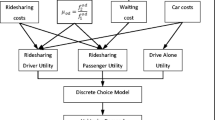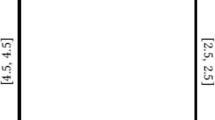Abstract
With the development of the Internet and mobile phone technology, it is much easier to access ridesharing information via mobile applications. In this paper, the relationship between the demand of ridesharing passengers (RPs), ridesharing drivers (RDs) and solo drivers (SDs) in a ridesharing compensation scheme is studied by a stochastic ridesharing user equilibrium (SRUE), which contains a mode choice model and a route choice model. The mode choice model and the route choice model influence each other. The SRUE is first expressed as a fixed-point problem mathematically. Six possible states of OD pairs are discussed. Then the existence of SRUE is proved. The method of successive weighted averages is adopted to solve the problem. It is found that there will be a higher demand of ridesharing passengers for journeys with longer travel time. Moreover, with the increase of the ridesharing compensation, the demand of ridesharing passengers is not always decreasing, and the demand of ridesharing drivers is not always increasing.




Similar content being viewed by others
References
Aashtiani HZ, Magnanti TL (1981) Equilibria on a congested transportation network. J Algebraic Discret Methods 2(3):213–226
Agatz N, Erera AL, Savelsbergh MW, Wang X (2011) Dynamic ride-sharing: a simulation study in metro Atlanta. Procedia Soc Behav Sci 17:532–550
Amey A (2011) Proposed methodology for estimating rideshare viability within an organization: application to the MIT community. Transportation Research Board annual meeting 2011, Paper 11–2585
Bahat O, Bekhor S (2016) Incorporating ridesharing in the static traffic assignment model. Netw Spat Econ 16(4):1125–1149
Beckmann M, McGuire CB, Winsten CB (1956) Studies in the economics of transportation. Yale University Press
Bureau of Transportation Statistics (2013) (2014) Transportation statistics annual report 2012, 2013. U.S. Department of Transportation, Research and Innovative Technology Administration Bureau of Transportation Statistics, Washington, DC
Bureau of Public Roads (1964) Traffic assignment manual. U.S. Department of commerce, Urban Planning Division, Washington, DC
Dafermos S (1980) Traffic equilibrium and variational inequalities. Transp Sci 14(1):42–54
Daganzo CF, Sheffi Y (1977) On stochastic models of traffic assignment. Transp Sci 11(3):253–274
Daganzo CF (1981) Equilibrium model for carpools on an urban network. Transp Res Rec 835:74–79
Farahani RZ, Miandoabchi E, Szeto WY, Rashidi H (2013) A review of urban transportation network design problems. Eur J Oper Res 229(2):281–302
Furuhata M, Dessouky M, Ordóñez F, Brunet ME, Wang X, Koenig S (2013) Ridesharing: the state-of-the-art and future directions. Transp Res B Methodol 57:28–46
Ghoseiri K, Haghani A, Hamedi M (2011) Real-Time Rideshare Matching Problem. Final Report of UMD-2009-05, University of Maryland, Department of Civil and Environmental Engineering
Huang HJ, Liu TL, Guo X, Yang H (2011) Inefficiency of logit-based stochastic user equilibrium in a traffic network under ATIS. Netw Spat Econ 11(2):255–269
Kleiner A, Nebel B, Ziparo V (2011) A mechanism for dynamic ride sharing based on parallel auctions. The 22nd Int Joint Conf Artif Intell (IJCAI), Barcelona, Spain 11:266–272
Liu HX, He X, He B (2009) Method of successive weighted averages (MSWA) and self-regulated averaging schemes for solving stochastic user equilibrium problem. Netw Spat Econ 9(4):485–503
Liu Y, Li Y (2017) Pricing scheme design of ridesharing program in morning commute problem. Transp Res C: Emerg Technol 79:156–177
Liu Z, Yi W, Wang S, Chen J (2017) On the uniqueness of user equilibrium flow with speed limit. Netw Spat Econ 17(3):763–775
Long JC, Gao ZY, Zhang H, Szeto WY (2010) A turning restriction design problem in urban road networks. Eur J Oper Res 206(3):569–578
Long JC, Szeto WY, Huang HJ (2014) A bi-objective turning restriction design problem in urban road networks. Eur J Oper Res 237(2):426–439
Qian ZS, Zhang HM (2011) Modeling multi-modal morning commute in a one-to-one corridor network. Transp Res C: Emerg Technol 19(2):254–269
Schrank D, Lomax T (2007) The 2007 urban mobility report. Texas transportation institute, Texas A & M University
Site PD (2017) On the equivalence between SUE and Fixed-point states of day-to-day assignment processes with serially-correlated route choice. Netw Spat Econ 17(3):935–962
Song Z, Yin Y, Lawphongpanich S (2015) Optimal deployment of managed lanes in general networks. Int J Sustain Transport 9(6):431–441
Terazono Y, Matani A (2015) Continuity of optimal solution functions and their conditions on objective functions. J Opt 25(4):2050–2060
Unnikrishnan A, Waller ST (2009) User equilibrium with recourse. Netw Spat Econ 9:575–593
Wardrop JG (1952) Some theoretical aspects of road traffic research. Proc Instit Civil Eng 1(3):325–362
Wang J, Du M, Lu L, He X (2018) Maximizing network throughput under stochastic user equilibrium with elastic demand. Netw Spat Econ 18(1):115–143
Winter S, Nittel S (2006) Ad hoc shared-ride trip planning by mobile geosensor networks. Int J of Geogr Inf Sci 20(8):899–916
Xing X, Warden T, Nicolai T, Herzog O (2009) SMIZE: a spontaneous ride-sharing system for individual urban transit. German conference on multiagent system technologies. Springer Berlin, Heidelberg, pp 165–176
Xu H, Ordóñez F, Dessouky M (2015a) A traffic assignment model for a ridesharing transportation market. J Adv Transp 49(7):793–816
Xu H, Pang JS, Ordóñez F, Dessouky M (2015b) Complementarity models for traffic equilibrium with ridesharing. Transp Res B Methodol 81:161–182
Yang H, Huang HJ (1999) Carpooling and congestion pricing in a multilane highway with high-occupancy-vehicle lanes. Transp Res A: Policy Pract 33(2):139–155
Yin YF, Yang H (2003) Simultaneous determination of the equilibrium market penetration and compliance rate of advanced traveler information systems. Transp Res A: Policy Pract 37(2):165–181
Acknowledgements
This work was supported by the Key Research and Development Program (No. 2016YFC0802508), and the National Natural Science Foundation of China (Nos.11672289, 71621001, 71631002).
Author information
Authors and Affiliations
Corresponding author
Additional information
Publisher’s Note
Springer Nature remains neutral with regard to jurisdictional claims in published maps and institutional affiliations.
Appendix
Appendix
Theorem 1
If the driving cost function \( {c}_v^w\left({t}_e^w\right) \) is a continuous and monotone increasing function of the equilibrium travel time \( {t}_e^w \), then the mapping function q =MC(te) is continuous.
Proof
Firstly, we prove that \( {q}_{rp}^w \), \( {q}_{rd}^w \) and \( {q}_{sd}^w \) are unique for any \( {t}_e^w \).
If the driving cost function \( {c}_v^w={c}_v^w\left({t}_e^w\right) \) is a monotone increasing function of the equilibrium travel time \( {t}_e^w \), its inverse function \( {t}_e^w={c_v^w}^{-1}\left({c}_v^w\right) \) is also a monotone increasing function.
Tables 1 and 2 show that each OD has six possible states according to the different value of δ and \( {c}_v^w \). Let’s firstly consider the first one of the six states: State 1 where δ > 0 and \( {c}_v^w<{c_v^w}^{\ast } \), which means \( {t}_e^w<{c_v^w}^{-1}\left({c_v^w}^{\ast}\right) \), \( {c}_{sd}^w<{\overline{c}}_{rd}^w<{\overline{c}}_{rp}^w \), \( {c}_{sd}^w<{c}_{rd}^w<{c}_{rp}^w \), \( {c}_{sd}^w<{c}_{rd}^w<{\overline{c}}_{rd}^w \) and \( {q}_{rp}^w<{q}_{rd}^w \). Let’s denote a function \( f\left(c,t\right)=c-\left({e}^{\theta c-{\theta c}_{rp}^w}\right){\overline{c}}_{rd}^w-\left(1-{e}^{\theta c-{\theta c}_{rp}^w}\right){c}_{sd}^w \). The partial derivative of f(c, t) on c is \( \frac{\partial f}{\partial c}=1-\theta \left({\overline{c}}_{rd}^w-{c}_{sd}^w\right){e}^{\theta c-{\theta c}_{rp}^w} \). For \( {c}_{sd}^w<{\overline{c}}_{rp}^w \), so \( \frac{\partial f}{\partial c}>0 \), which means it’s monotone increasing on c in State 1 if t is given. We can get that \( f\left({c}_{sd}^w,t\right)={c}_{sd}^w-\left({e}^{\theta {c}_{sd}^w-{\theta c}_{rp}^w}\right){\overline{c}}_{rd}^w-\left(1-{e}^{\theta {c}_{sd}^w-{\theta c}_{rp}^w}\right){c}_{sd}^w={e}^{\theta {c}_{sd}^w-{\theta c}_{rp}^w}\left({c}_{sd}^w-{\overline{c}}_{rd}^w\right)<0 \) and \( f\left({\overline{c}}_{rd}^w,t\right)={\overline{c}}_{rd}^w-\left({e}^{\theta {\overline{c}}_{rd}^w-{\theta c}_{rp}^w}\right){\overline{c}}_{rd}^w-\left(1-{e}^{\theta {\overline{c}}_{rd}^w-{\theta c}_{rp}^w}\right){c}_{sd}^w=\left(1-{e}^{\theta {\overline{c}}_{rd}^w-{\theta c}_{rp}^w}\right)\left({\overline{c}}_{rd}^w-{c}_{sd}^w\right)>0 \). We have known that the function \( f\left({c}_{sd}^w,{t}_e^w\right) \) is monotone increasing when the value of c is between \( {c}_{sd}^w \) and \( {\overline{c}}_{rd}^w \), and\( f\left({c}_{sd}^w\right)<0 \), \( f\left({\overline{c}}_{rd}^w\right)>0 \). As a result, there is one and only one \( c={c}_{rd}^w \) that \( f\left({c}_{rd}^w,{t}_e^w\right)=0 \). \( {c}_{rp}^w \) and \( {c}_{sd}^w \) can be obtained from Eqs. (4) and (16). As a result, the value of \( {c}_{rp}^w \), \( {c}_{rd}^w \) and \( {c}_{sd}^w \) is unique when \( {t}_e^w<{c_v^w}^{-1}\left({c_v^w}^{\ast}\right) \). By Eq. (13), \( {q}_{rp}^w \), \( {q}_{rd}^w \) and \( {q}_{sd}^w \) are unique when \( {t}_e^w<{c_v^w}^{-1}\left({c_v^w}^{\ast}\right) \).
For a similar reason, we can get that \( {q}_{rp}^w \), \( {q}_{rd}^w \) and \( {q}_{sd}^w \) are unique for the other five states. As a result, \( {q}_{rp}^w \), \( {q}_{rd}^w \) and \( {q}_{sd}^w \) are unique for any \( {t}_e^w \).
Then we prove that \( {q}_{rp}^w \), \( {q}_{rd}^w \) and \( {q}_{sd}^w \) are continuous at \( {t}_e^w \).
We still consider State 1 as an example. \( {c}_{rp}^w \) and \( {c}_{sd}^w \) are obtained from Eqs. (2) and (4). Obviously, \( {c}_{rp}^w \) and \( {c}_{sd}^w \) are continuous at \( {t}_e^w \). \( {c}_{rd}^w \) is obtained by solving Eq. (16). We have proved that \( {c}_{rd}^w \) is unique for any \( {t}_e^w \). Therefore, \( {c}_{rd}^w \) can be viewed as a function of \( {t}_e^w \). Denote the function is \( {c}_{rd}^w=h\left({t}_e^w\right) \). If c0 and t0 satisfy c0 = h(t0), we want to prove h(t) is continuous at t0. For \( \frac{\partial f}{\partial c}>0 \) in State 1, f(c0 + ε, t0) > 0 and f(c0 − ε, t0) < 0. For f(c, t) is continuous at t, ∃t ∈ (t0 − δ, t0 + δ ), f(c0 + ε, t) > 0 and f(c0 − ε, t) < 0. Therefore c0 + ε < h(t) < c0 − ε. As a result, \( {c}_{rd}^w=h\left({t}_e^w\right) \) is continuous at t0. Therefore, \( {c}_{rp}^w \), \( {c}_{rd}^w \) and \( {c}_{sd}^w \) are continuous at \( {t}_e^w \). By Eq. (13), \( {q}_{rp}^w \), \( {q}_{rd}^w \) and \( {q}_{sd}^w \) are obtained by \( {c}_{rp}^w \), \( {c}_{rd}^w \) and \( {c}_{sd}^w \). In another word, \( {q}_{rp}^w \), \( {q}_{rd}^w \) and \( {q}_{sd}^w \) are continuous at \( {t}_e^w \) in this case.
For the other five states, we can get the same conclusion for similar reasons. Therefore, \( {q}_{rp}^w \), \( {q}_{rd}^w \) and \( {q}_{sd}^w \) are continuous at \( {t}_e^w \).
Rights and permissions
About this article
Cite this article
Yan, CY., Hu, MB., Jiang, R. et al. Stochastic Ridesharing User Equilibrium in Transport Networks. Netw Spat Econ 19, 1007–1030 (2019). https://doi.org/10.1007/s11067-019-9442-5
Published:
Issue Date:
DOI: https://doi.org/10.1007/s11067-019-9442-5




